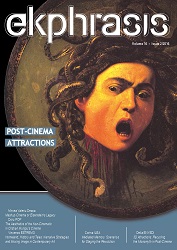Mashup Cinema or Eisenstein’s Legacy
Mashup Cinema or Eisenstein’s Legacy
Author(s): Mircea Valeriu DeacaSubject(s): Fine Arts / Performing Arts
Published by: Universitatea Babeş-Bolyai, Facultatea de Teatru si Televiziune
Keywords: Cognition; film analysis; mashup cinema; cinematic topoi; cognitive grammar; postmodernism; carnival; cinema of attractions; discontinuity; narrative
Summary/Abstract: The paper focuses on the supposed fundamental change in contemporary films. After a short survey of several points of view on the matter I discuss the case of mashup cinema. This genre is based on recycling of cinematic sequences in order to create new narrative and fictional discourses. Contrary to Dada’s rhetoric, mashup cinema is prone to create narratives based on continuity. New semantic constructions are elaborated out of heterogeneous filmic scenes and sequences. Discontinuities, viewed as autonomous sequences, are enjoyed per se. Sequences are further bound by narrative roles, and by abstract and sensorial modifiers such as music, movement, shapes and colors. This characteristic has been, since its birth, an explanatory element of what we call film.Today’s mashup cinema tends to become an audiovisual hieroglyphic language available to viewers and users situated at both ends of the spectrum, i.e. producers and addressees. Faced with this democratization of audiovisual use poststructuralist philosophical approaches have a gist of panic, and today’s films and shorts are considered to be the epiphenomena announcing an apocalypse. Film analysts like David Bordwell, Roger Odin or Laurent Jullier adopt a more sober stance and study the new shifts in emphasis and the innovative use of new constructional schemas in a manner closer to the filmic text. Cinematic discourse, through the use of prefabricated chunks, cinematic topoi, is evolving towards a language which resembles the medieval literature and carnival where a common cultural thesaurus was available to users in order to create new conceptualizations and reality conceptions.
Journal: Ekphrasis. Images, Cinema, Theory, Media
- Issue Year: 16/2016
- Issue No: 2
- Page Range: 24-45
- Page Count: 21
- Language: English

